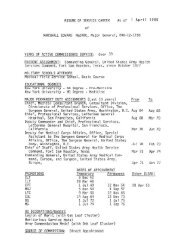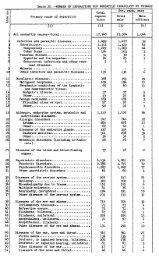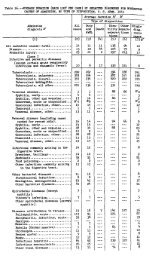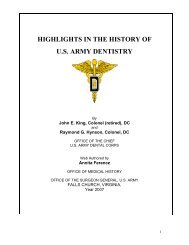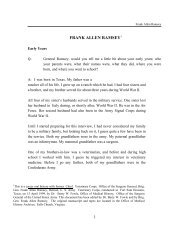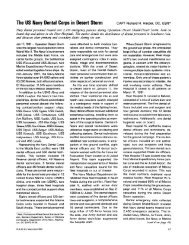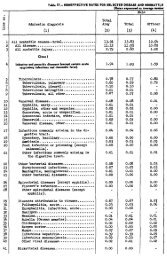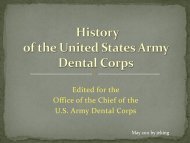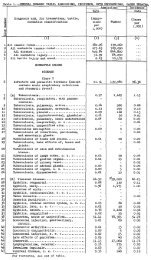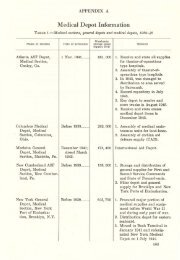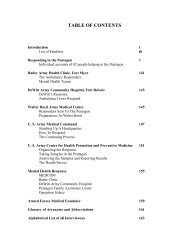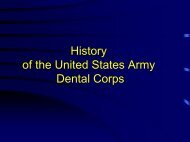brig. gen. frank allen ramsey - Office of Medical History - U.S. Army
brig. gen. frank allen ramsey - Office of Medical History - U.S. Army
brig. gen. frank allen ramsey - Office of Medical History - U.S. Army
You also want an ePaper? Increase the reach of your titles
YUMPU automatically turns print PDFs into web optimized ePapers that Google loves.
ARMY MEDICAL DEPARTMENT PROFILES<br />
BRIG. GEN. FRANK ALLEN RAMSEY<br />
Veterinary Corps<br />
U.S. <strong>Army</strong><br />
<strong>Office</strong> <strong>of</strong> <strong>Medical</strong> <strong>History</strong><br />
<strong>Office</strong> <strong>of</strong> the Surgeon General<br />
Alexandria, Virginia<br />
June 2002<br />
i
<strong>Army</strong> <strong>Medical</strong> Department Pr<strong>of</strong>iles<br />
ii
Frank Allen Ramsey<br />
Foreword<br />
In 1998, Lt. Gen. Ronald R. Blanck, Surgeon General <strong>of</strong> the <strong>Army</strong>, reestablished<br />
an <strong>of</strong>ficial historical program under a new <strong>Office</strong> <strong>of</strong> <strong>Medical</strong> <strong>History</strong>. Oral history forms<br />
a central element in the new program, which will conduct regular interviews with key<br />
<strong>Office</strong> <strong>of</strong> the Surgeon General and <strong>Medical</strong> Command active and retired personnel,<br />
publish selected interviews in a ‟<strong>Medical</strong> Memoir” series, and provide coverage <strong>of</strong><br />
current operations and issues with participants and decision makers.<br />
The first interview to be published in the <strong>Medical</strong> Memoir series is one conducted<br />
by Col. Robert B. McLean, <strong>Medical</strong> Corps, with Lieut. Gen. Leonard D. Heaton under<br />
the Senior <strong>Office</strong>rs Oral <strong>History</strong> Program at the Military <strong>History</strong> Institute, United States<br />
<strong>Army</strong> War College, Carlisle Barracks, in 1978. General Ramsey’s Veterinary Corps<br />
Pr<strong>of</strong>iles oral history was conducted on 15 April 1999, at Fort Sam Houston, Texas, by<br />
Barry W. Fowle, Ph.D., <strong>Office</strong> <strong>of</strong> <strong>Medical</strong> <strong>History</strong>.<br />
General Ramsey’s oral history reflects a lifetime <strong>of</strong> successes in command and<br />
staff positions, and provides a valuable source <strong>of</strong> veterinarian history for the inquiring<br />
researcher, be he historian or veterinarian.<br />
iii
<strong>Army</strong> <strong>Medical</strong> Department Pr<strong>of</strong>iles<br />
The Interviewer<br />
Dr. Barry W. Fowle, formerly a historian with Headquarters, United States <strong>Army</strong><br />
Corps <strong>of</strong> Engineers from 1983 to 1998, is now a senior contract historian with the <strong>Office</strong><br />
<strong>of</strong> <strong>Medical</strong> <strong>History</strong>, <strong>Office</strong> <strong>of</strong> The Surgeon General <strong>of</strong> the United States <strong>Army</strong>. He<br />
received a B.A. from the University <strong>of</strong> the Philippines and an M.A. and Ph.D. from the<br />
University <strong>of</strong> Maryland. He is editor <strong>of</strong> Builders and Fighters: United States <strong>Army</strong><br />
Engineers in World War II, and co-author <strong>of</strong> The 51st Again: An Engineer Battalion in<br />
World War II. Dr. Fowle retired in September, 1971, as a lieutenant colonel, Signal<br />
Corps, with 23 years <strong>of</strong> service in the United States <strong>Army</strong>.<br />
iv
Frank Allen Ramsey<br />
CONTENTS<br />
Foreword............................................................................................................................ iii<br />
The Interviewer.................................................................................................................. iv<br />
Frank Allen Ramsey ........................................................................................................ viii<br />
Personal Data ....................................................................................................... xiii<br />
Career Summary ...................................................................................... xiii<br />
Awards ...................................................................................................................xv<br />
Career Interview ..................................................................................................................1<br />
Early Years ..............................................................................................................3<br />
Texas Agricultural and Mechanical University [TA&MU] 1947 to 1954 ..............4<br />
The <strong>Army</strong> Veterinary Corps ....................................................................................4<br />
The <strong>Army</strong> <strong>Medical</strong> Department <strong>Office</strong>r Basic Course ............................................5<br />
The United States <strong>Army</strong> <strong>Medical</strong> Department Veterinary School,<br />
Chicago, Illinois, 1955.................................................................................5<br />
Commander, 73d <strong>Medical</strong> Detachment Veterinary Service, La Rochelle,<br />
France, 1955 to 1957 ...................................................................................5<br />
Encounters with the Military Police ......................................................................10<br />
New Offshore Discharge Exercises (NODEX)......................................................12<br />
Submarine Pens at La Pallice.................................................................................14<br />
Procurement <strong>of</strong> Seafood, Cadiz, Spain ..................................................................15<br />
Berlin Command, 1957 to 1958.............................................................................15<br />
Donuts in Berlin.........................................................................................17<br />
Disbanding the Horses, the United States Constabulary<br />
Berlin Command............................................................................18<br />
The Decision to Stay in the <strong>Army</strong> .........................................................................21<br />
Marriage to Lucette Claudine Reboul....................................................................23<br />
Post Veterinary <strong>Office</strong>r, Fort Leonard Wood, Missouri, 1958 to 1961.................24<br />
Post Preventive Medicine <strong>Office</strong>r..............................................................25<br />
Colonel John T.B. Strode...........................................................................28<br />
Veterinary <strong>Office</strong>r, United States Military Academy, West Point,<br />
New York, 1962 to 1964............................................................................32<br />
Four United States <strong>Army</strong> Mules ................................................................33<br />
Preventive Medicine <strong>Office</strong>r, West Point, New York ...............................38<br />
Heat Injuries...............................................................................................38<br />
v
<strong>Army</strong> <strong>Medical</strong> Department Pr<strong>of</strong>iles<br />
The Hotel Thayer .......................................................................................39<br />
The Cadet Mess .........................................................................................40<br />
Sheila McDonough in the Cadet Rooms at West Point .............................43<br />
Tulip Beds..................................................................................................44<br />
Command & General Staff College, Fort Leavenworth,<br />
Kansas,1964 to 1965..................................................................................45<br />
Combat Development Command, Fort Sam Houston, Texas, 1965 to 1967.........47<br />
<strong>Office</strong> <strong>of</strong> the Surgeon General, Washington, DC, 1967 to 1971 ...........................49<br />
Reorganizing the TO&Es...........................................................................51<br />
Portable Jet Injector ...................................................................................52<br />
Program to Obtain an Improved Military Working Dog ...........................53<br />
Retrievable Dog Shipping Containers .......................................................53<br />
Recording Thermometers...........................................................................54<br />
Reorganization <strong>of</strong> the Veterinary School...................................................56<br />
Validating Positions for Graduate Training <strong>of</strong> Veterinary <strong>Office</strong>rs ..........56<br />
Veterinary Corps <strong>Office</strong>rs Guide...............................................................61<br />
Development <strong>of</strong> <strong>Army</strong> Standard Plans for Construction <strong>of</strong> Veterinary<br />
Facilities at Posts, Camps, and Stations.....................................................63<br />
The <strong>Army</strong> War College, Carlisle Barracks, Pennsylvania,1971 to 1972 ..............63<br />
Chief <strong>of</strong> the Food Inspection Policy <strong>Office</strong>, Chief, Veterinary Corps, <strong>Office</strong> <strong>of</strong> the<br />
Surgeon General [OTSG], 1972 to 1977 ...................................................65<br />
Abolishing the <strong>Army</strong> Veterinary Corps.....................................................66<br />
Coincidence?..............................................................................................71<br />
Assistant Chief <strong>of</strong> Staff for Veterinary Services, 7th <strong>Medical</strong> Command,<br />
United States <strong>Army</strong>, Europe, 1977 to 1980 ...............................................72<br />
Communicating with the Command ..........................................................73<br />
Ticker Tape Communications....................................................................74<br />
Annual Military Veterinary <strong>Medical</strong> Training Conference .......................75<br />
International Near-Catastrophe..................................................................77<br />
Procurement <strong>of</strong> Food in Europe.................................................................78<br />
Commanding the Various Teams...............................................................79<br />
Combat Casualty Care Course...................................................................81<br />
Advertising the Veterinary Program..........................................................83<br />
Consolidating the <strong>Army</strong> and the Air Force Veterinary Services...............85<br />
Promotion to Brigadier General.................................................................87<br />
vi
Frank Allen Ramsey<br />
Chief, Veterinary Corps, <strong>Office</strong>, Surgeon General, United States<br />
<strong>Army</strong>, Washington, DC; Assistant Surgeon General<br />
for Veterinary Services, <strong>Office</strong>, Surgeon General,<br />
United States <strong>Army</strong>, Washington, DC; Acting Department<br />
<strong>of</strong> Defense, Executive A<strong>gen</strong>t for Veterinary Services, 1980 to 1985;<br />
and Deputy Commander, United States <strong>Army</strong> <strong>Medical</strong><br />
Research & Development Command, Fort Detrick, Maryland,<br />
1984 to 1985 ..............................................................................................87<br />
Integration <strong>of</strong> <strong>Army</strong> and Air Force Veterinary Services ...........................88<br />
The Veterinary <strong>Office</strong>rs Guide...................................................................91<br />
Assignment <strong>of</strong> R&D <strong>Office</strong>rs ....................................................................93<br />
Quarters at Fort Myer, Virginia .................................................................96<br />
American Veterinary <strong>Medical</strong> Association................................................97<br />
Memorabilia and Souvenirs .........................................................100<br />
The Total <strong>Army</strong> Concept .............................................................100<br />
Warrant <strong>Office</strong>r Food Inspector Career Field..............................101<br />
Distinctive Insignia......................................................................102<br />
Meals Ready to Eat ..................................................................................102<br />
Retirement, 1985..................................................................................................108<br />
Glossary ...............................................................................................................112<br />
Photographs<br />
Frank Allen Ramsey: Retirement in Uvalde...................................................................109<br />
vii
<strong>Army</strong> <strong>Medical</strong> Department Pr<strong>of</strong>iles<br />
Frank Allen Ramsey<br />
Frank Allen Ramsey was born in Texas.<br />
He became interested in veterinary work while working for the husband <strong>of</strong> one <strong>of</strong><br />
his sisters before and during high school. He attended high school in Uvalde,<br />
Texas, and upon graduation in 1947, went to Texas Agricultural and Mechanical<br />
[TA&M] University, where he received his degree in veterinary medicine in<br />
1954.<br />
Upon graduation, Ramsey went to Fort Worth and worked for the United<br />
States Department <strong>of</strong> Agriculture in their Meat Inspection Division. Rather than<br />
be drafted into the <strong>Army</strong>, Ramsey volunteered to serve in the <strong>Army</strong> Veterinary<br />
Corps in 1955. He originally intended to only serve his two year requirement.<br />
However, Ramsey realized that economic conditions were not conducive to going<br />
into private practice; therefore, he decided to continue his service in the <strong>Army</strong>.<br />
He reported to the <strong>Medical</strong> Field Service School at Fort Sam Houston, Texas,<br />
where he attended the three month <strong>Medical</strong> Department <strong>Office</strong>r Basic Course.<br />
Ramsey then attended the United States <strong>Army</strong> <strong>Medical</strong> Department<br />
Veterinary School located in Chicago, Illinois. The meat packing houses in<br />
Chicago were essential training aids for the school. There, he learned how to<br />
grade meat according to quality and how to inspect the meat for sanitation. That<br />
school lasted two to three months.<br />
Having completed that course, Ramsey received orders to La Rochelle,<br />
France to be commander <strong>of</strong> the 73d <strong>Medical</strong> Detachment Veterinary Service, a<br />
twelve man TO&E unit. He provided veterinary service for the northern and<br />
western sections <strong>of</strong> BASEC [Base Section] in the Communications Zone<br />
[COMZ]. His specific duties included inspection <strong>of</strong> all food provided for U.S.<br />
forces in Europe. While most non-perishables were delivered to La Rochelle<br />
from the U.S., perishable items, such as meat and eggs, were purchased in<br />
Europe. Ramsey encountered many problems finding facilities in post-war<br />
Europe that met U.S. sanitary requirements for providing perishable items.<br />
In 1957, Ramsey received orders to become Berlin Command<br />
Veterinarian. During this assignment, the last horse-mounted unit in the <strong>Army</strong>,<br />
viii
Frank Allen Ramsey<br />
stationed in Berlin, was disbanded. A number <strong>of</strong> horses were sent down to the<br />
U.S. <strong>Army</strong> in France. However, Ramsey was tasked with what to do should one<br />
<strong>of</strong> the remaining horses die. A study was conducted and it was concluded that the<br />
horses would be flown back to the United States for disposal.<br />
In 1958, General Ramsey received orders to Fort Leonard Wood,<br />
Missouri. As Post Veterinarian, his job was similar to what it had been in Europe.<br />
Food inspection was the primary function. He inspected the various food<br />
establishments in the area (dairy products, meat, vegetables, eggs, and poultry), as<br />
well as incoming shipments <strong>of</strong> subsistence already procured for the <strong>Army</strong>. He<br />
also performed establishment sanitary inspections on all the food handling<br />
establishments on post. This included the dining facilities, the mess halls, the post<br />
bakery, the post meat cutting plant, the commissary, all <strong>of</strong> the post exchange<br />
activities, and the <strong>of</strong>ficer, NCO, and enlisted clubs. Ramsey also took care <strong>of</strong><br />
approximately 50 horses, plus the working dogs assigned to Fort Leonard Wood.<br />
Another assigned duty included that <strong>of</strong> acting Preventive Medicine <strong>Office</strong>r<br />
[PMO]. Normally a <strong>Medical</strong> Corps position, the Post Surgeon was short <strong>of</strong><br />
medical doctors so he sent Ramsey to the four-month orientation course at Fort<br />
Sam Houston, Texas, to train him for this position. Preventive medicine involved<br />
the immunization program at the Engineer School, the Engineer Training Center,<br />
and at the Basic and Advanced Course. It included insect and rodent control,<br />
water testing, water wells, chlorination and fluoridation, the sewage disposal<br />
plant, the water purification plant, rabies control, and much more.<br />
In 1962, Ramsey received orders to the United States Military Academy,<br />
West Point, New York, for assignment as the USMA Veterinarian. His first job<br />
was to obtain equipment and supplies for the veterinary clinic. This was made<br />
easier since, within a few days <strong>of</strong> his arrival, he successfully provided emer<strong>gen</strong>cy<br />
services to the cat belonging to the president <strong>of</strong> the <strong>Office</strong>r’s Wives Club.<br />
Ramsey also introduced four U.S. <strong>Army</strong> <strong>of</strong>ficial U.S. government property<br />
mascot mules, which were housed at West Point, to the Academy football games.<br />
He obtained special West Point colored tack for the mules, and four to eight cadet<br />
mule riders were elected by the Cadet Corps to ride the mules and perform<br />
equestrian acrobatics during the games.<br />
ix
<strong>Army</strong> <strong>Medical</strong> Department Pr<strong>of</strong>iles<br />
Ramsey also served as PMO at the Academy. While serving in this<br />
position, Ramsey was able to institute a number <strong>of</strong> reforms in how food was<br />
handled. He also instituted a new program to determine how much training should<br />
occur in hot weather. In its first year <strong>of</strong> operation, there were no heat exhaustion<br />
cases, compared with dozens the year before.<br />
In 1964, Ramsey received orders to attend the first 10-month course at the<br />
Command and General Staff College in Fort Leavenworth, Kansas. This crosstraining<br />
experience was quite beneficial for Ramsey, as he was able to learn what<br />
other <strong>Army</strong> organizations were doing. This led him to do his job better and also to<br />
support others better. He graduated in 1965.<br />
From Fort Leavenworth, Ramsey went to the <strong>Medical</strong> Service A<strong>gen</strong>cy <strong>of</strong><br />
the Combat Development Command at Fort Sam Houston. Here, he worked on<br />
the reorganization <strong>of</strong> the TO&E army veterinary service units. Personnel and<br />
equipment evaluation was based on early reports from Vietnam.<br />
From 1967 to 1971, Ramsey was assigned to the <strong>Office</strong> <strong>of</strong> the Surgeon<br />
General, first as assistant Chief, then as Chief, Pr<strong>of</strong>essional Services <strong>Office</strong>. He<br />
continued his reorganization work <strong>of</strong> the TO&E army veterinary service units.<br />
Ramsey was also able to significantly increase the number <strong>of</strong> validated positions<br />
for graduate training <strong>of</strong> veterinary <strong>of</strong>ficers. At the request <strong>of</strong> the Chief, Veterinary<br />
Corps, Brig. Gen. George A. Kuhn, Ramsey also developed a Veterinary Corps<br />
<strong>Office</strong>rs Guide. This guide was created to orient new Veterinary Corps <strong>Office</strong>rs.<br />
Ramsey received orders for the War College, Carlisle Barracks,<br />
Pennsylvania, in 1971. He was the first veterinary <strong>of</strong>ficer to attend the resident<br />
course.<br />
Upon graduation in 1972, Ramsey was assigned back to the <strong>Office</strong> <strong>of</strong> the<br />
Surgeon General. He served as Chief, Food Inspection Policy <strong>Office</strong>, then later as<br />
Chief, Pr<strong>of</strong>essional Policy and Doctrine <strong>Office</strong>, and as Senior Veterinary Corps<br />
Staff <strong>Office</strong>r and Chief, Field Inspection <strong>Office</strong>, <strong>Office</strong>, Chief, Veterinary Corps.<br />
During his service at the <strong>Office</strong> <strong>of</strong> the Surgeon General, there were 25 separate<br />
in-depth studies <strong>of</strong> the <strong>Army</strong> Veterinary Service, all with the sole objective <strong>of</strong><br />
x
Frank Allen Ramsey<br />
eliminating the service. As the staff <strong>of</strong>ficer for each study, Ramsey had to educate<br />
each group as to the diverse nature <strong>of</strong> the Veterinary Corps’ duties. There were<br />
studies by the <strong>Army</strong> IG, the Surgeon General’s <strong>Office</strong>, by the Government<br />
Accounting <strong>Office</strong>, and by the Judge Advocate General’s <strong>Office</strong>, among others.<br />
None <strong>of</strong> the studies were able to reduce the Veterinary Corps in any way.<br />
Ramsey was assigned as the United States <strong>Army</strong> Europe Veterinarian and<br />
as the Assistant Chief <strong>of</strong> Staff for Veterinary Services, 7th <strong>Medical</strong> Command,<br />
United States <strong>Army</strong>, Europe, from 1977 to 1980. He expanded an international<br />
veterinary medical training conference, usually held in Garmisch, to enable<br />
veterinary <strong>of</strong>ficers serving overseas to garner continuing education credits.<br />
Ramsey also emphasized the Combat Casualty Care surgical program in Europe,<br />
using goats for training. He also worked closely with the Air Force in Europe<br />
where he began the process <strong>of</strong> integrating the Air Force Veterinary Service into<br />
the <strong>Army</strong>’s Veterinary Service.<br />
On 2 October 1980, Ramsey was promoted to <strong>brig</strong>adier <strong>gen</strong>eral. He then<br />
returned to the ZI [Zone <strong>of</strong> Interior] where he became the Chief, Veterinary<br />
Corps, <strong>Office</strong>, Surgeon General, United States <strong>Army</strong>. In March 1984, he was<br />
given the additional duty <strong>of</strong> Deputy Commander, United States <strong>Army</strong> <strong>Medical</strong><br />
R&D Command, Fort Detrick, Maryland. In this assignment, he oversaw the<br />
<strong>Army</strong> take-over <strong>of</strong> the Air Force Veterinary Service. He also revised the<br />
Veterinary <strong>Office</strong>rs Guide and republished it. He instigated a program whereby<br />
colonels in R&D who had never been overseas were sent overseas for assignment,<br />
taking the place <strong>of</strong> other colonels who had been overseas a number <strong>of</strong> times. It<br />
raised a fuss, but in the long run proved fruitful. During this entire tour he also<br />
served as Assistant Surgeon General for Veterinary Services and as the Acting<br />
Department <strong>of</strong> Defense Executive A<strong>gen</strong>t for Veterinary Services.<br />
Ramsey retired in February 1985, but was called back to active duty the<br />
following year to investigate why the OD plastic bag wrapper on Meals Ready to<br />
Eat [MRE] packets were swelling. A comprehensive team investigated, detailing<br />
the cause <strong>of</strong> the problem and what corrective measures were needed. Once<br />
implemented, these corrective measures took care <strong>of</strong> the problem. The problem<br />
was solved in less than eight weeks.<br />
xi
<strong>Army</strong> <strong>Medical</strong> Department Pr<strong>of</strong>iles<br />
Since retirement, Ramsey has spent his time farming and ranching in<br />
Uvalde, Texas.<br />
xii
Frank Allen Ramsey<br />
Career Summary<br />
1955<br />
1955<br />
Basic <strong>Office</strong>rs Course, Fort Sam Houston, Texas<br />
First lieutenant, 4 Jan 1955<br />
United States <strong>Army</strong> Veterinary School, Chicago, Illinois<br />
1955 to 1957<br />
Commander, 73d <strong>Medical</strong> Detachment, Veterinary Service, La Rochelle,<br />
France<br />
1957 to 1958<br />
Veterinarian, Berlin Command, USAREUR, Germany<br />
Captain, 15 May1958<br />
1958 to 1961<br />
Veterinary <strong>Office</strong>r and Preventive Medicine <strong>Office</strong>r, Fort Leonard Wood,<br />
Missouri<br />
1962 to 1964<br />
Veterinary <strong>Office</strong>r and Preventive Medicine <strong>Office</strong>r, United States<br />
Military Academy, West Point, New York<br />
Major, 27 Mar 1963<br />
xiii
<strong>Army</strong> <strong>Medical</strong> Department Pr<strong>of</strong>iles<br />
1964 to June 1965<br />
Student, Command and General Staff College, Fort Leavenworth, Kansas<br />
Jul 1965 to Jan 1967<br />
Project <strong>Office</strong>r, Doctrine Division, United States <strong>Army</strong> Combat<br />
Developments Command <strong>Medical</strong> Service A<strong>gen</strong>cy, Fort Sam Houston,<br />
Texas<br />
Lieutenant Colonel, 30 December 1966<br />
Feb 1967 to Jul 1971<br />
Assistant Chief, later Chief, Pr<strong>of</strong>essional Services <strong>Office</strong>, Assistant for<br />
Veterinary Services, <strong>Office</strong>, Surgeon General, United States <strong>Army</strong>,<br />
Washington, DC<br />
Aug 1971 to Jun 1972<br />
Student, United States <strong>Army</strong> War College, Carlisle Barracks,<br />
Pennsylvania<br />
Colonel, 8 May 1972<br />
Jun 1972 to Jun 1977<br />
Chief, Food Inspections Policy <strong>Office</strong>, later Chief, Pr<strong>of</strong>essional Policy and<br />
Doctrine <strong>Office</strong>, later Senior Veterinary Corps Staff <strong>Office</strong>r and Chief,<br />
Food Inspection <strong>Office</strong>, <strong>Office</strong>, Chief, Veterinary Corps, <strong>Office</strong>, Surgeon<br />
General, United States <strong>Army</strong>, Washington, DC<br />
Jul 1977 to Nov 1980<br />
Assistant Chief <strong>of</strong> Staff for Veterinary Services, 7 th <strong>Medical</strong> Command,<br />
United States <strong>Army</strong>, Europe and United States <strong>Army</strong> Europe Veterinarian<br />
Brigadier <strong>gen</strong>eral, 2 October 1980<br />
Nov 1980 to Mar 1984<br />
Chief, Veterinary Corps, <strong>Office</strong>, Surgeon General, United States <strong>Army</strong>,<br />
Washington, DC; Assistant Surgeon General for Veterinary Services,<br />
<strong>Office</strong>, Surgeon General, United States <strong>Army</strong>, Washington, DC; Acting<br />
Department <strong>of</strong> Defense Executive A<strong>gen</strong>t for Veterinary Services, <strong>Office</strong>,<br />
xiv
Frank Allen Ramsey<br />
Surgeon General, United States <strong>Army</strong>, Washington, DC.<br />
Mar 1984 to Feb 1985<br />
In addition to the above, was assigned Deputy Commander, United States<br />
<strong>Army</strong> <strong>Medical</strong> R&D Command, Fort Detrick, Frederick, Maryland<br />
Awards<br />
Distinguished Service Medal<br />
Legion <strong>of</strong> Merit (with one Oak Leaf Cluster)<br />
<strong>Army</strong> Commendation Medal<br />
xv
<strong>Army</strong> <strong>Medical</strong> Department Pr<strong>of</strong>iles<br />
xvi



